Mount Greenwood:
The Untold Story of a Northern School Integration

Chicago police protect 11 black students from white residents of Mount Greenwood in 1968. Chicago Daily News photo.
Globally, 1968 was a tumultuous year. Among the notable occurrences overtaken by the events of that year was the desegregation, in early 1968, of Mount Greenwood Elementary School on the far Southwest Side Chicago. It produced neighbourhood protests reminiscent of those accompanying the integration of Central High School in Little Rock, Arkansas, 10 years earlier. Several chroniclers of that decade agree that it was an important and overlooked chapter in Chicago’s civil rights history, and one that continues to reverberate. The story of the desegregation itself was told, in full for the first time, in Taddle Creek magazine, excerpted from Red Squad, my forthcoming memoir. Here, I follow up on those events and some of the key players:
The “integration” plan lasted only a year
The 1968 de facto desegregation of Mount Greenwood School through the permissive transfer plan was a one-time event. That plan, in place since the early sixties, was designed not so much for the purpose of integration as it was to relieve overcrowding. It was also not a busing program—the students’ parents were responsible for providing their transportation—although it was often confused with that.
Mount Greenwood School was considered for the programme again in 1969, but at the last minute, the Chicago Board of Education determined that it no longer met the criteria to be a receiving school.
That news was presented as a victory for the community in front-page story in the Southtown Economist, a neighbourhood newspaper, under the headline “Win Greenwood Fight.”
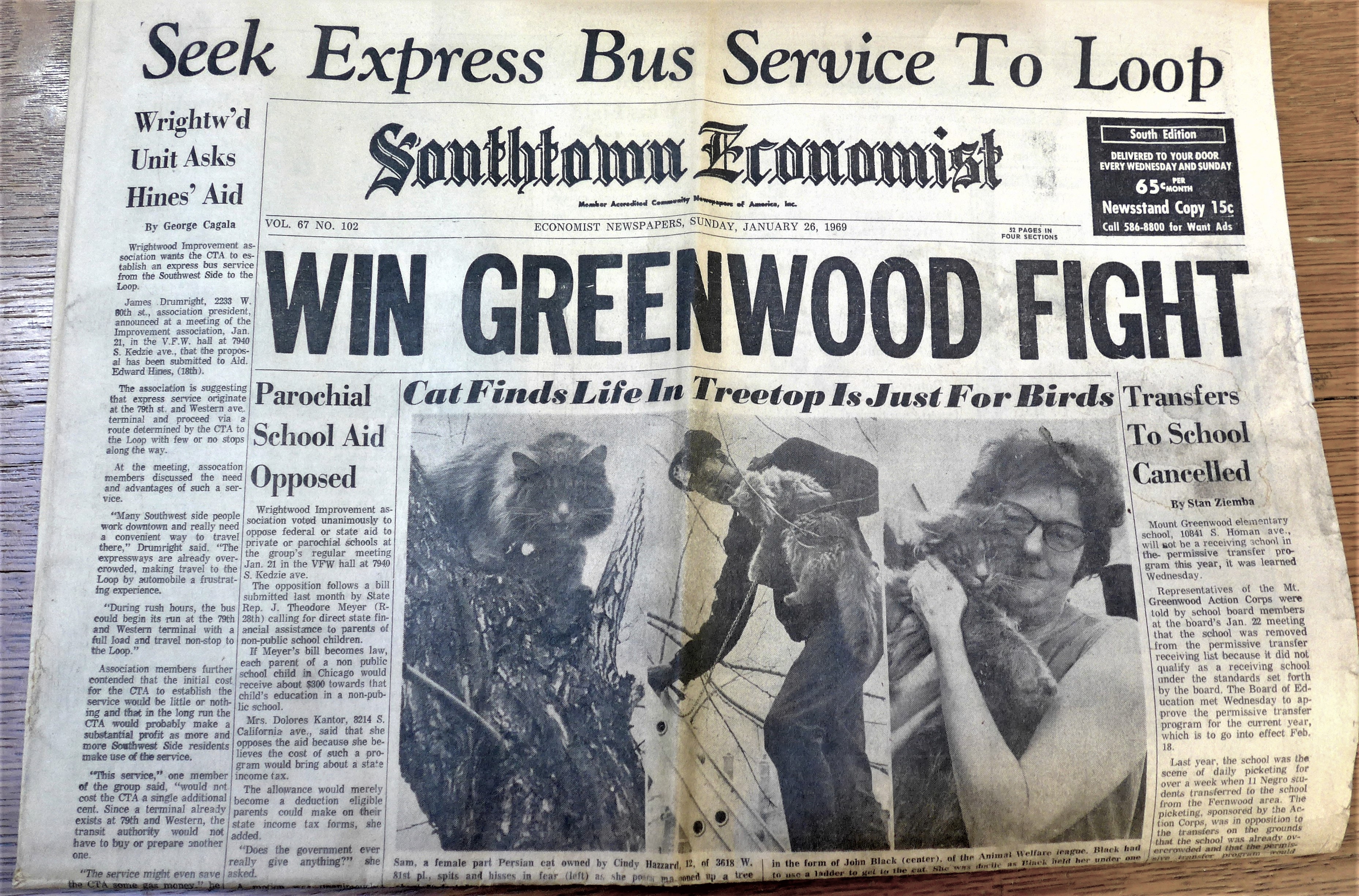
“The community can be relieved,” Southwest Side spokesman declares.
The main criterion to be a receiving school that year was to have enrollment that produced an average class size of no more than 31 students, according to the story. Mount Greenwood was reported to have 24 “available” classrooms and enrollment of 787 students, for an average class size of 32.8. The report noted that the school actually had a total of 30 rooms, but two rooms were used for kindergarten, one for home mechanics, one for industrial arts, and one was scheduled to become a classroom for educable mentally handicapped students.
The Mount Greenwood Action Corps, billed as a local civic group that sponsored the picketing that had greeted 11 black students who came to the school under the permissive transfer plan in 1968, opposed transfers for 1969 on the grounds that the school was already overcrowded and the presence of black students would “create instability in the neighborhood,” the story said.
William Heatherly, Mount Greenwood Action Corps president, welcomed the school board’s decision, saying, “The community can be relieved at least for another year.”
Steven Palmore of the “Mount Greenwood Seven”
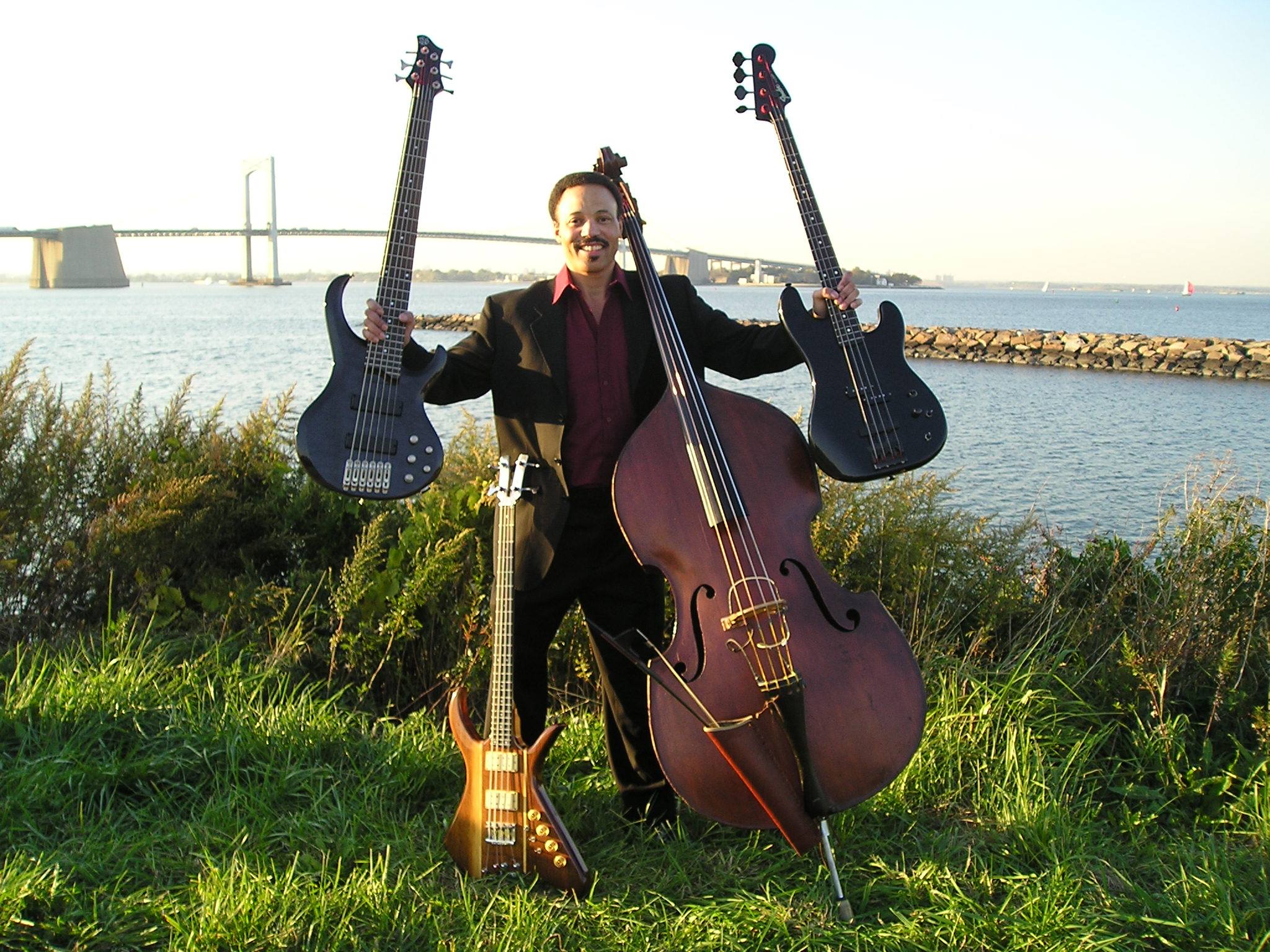
Steven Palmore and a few basses. From Facebook.
The hundreds of anti-integration demonstrators who turned out on his first day at Mount Greenwood School in January 1968 didn’t faze Steven Palmore.
“I was only 13, and 13-year-olds don’t know fear,” he said in an interview. “Plus, I’d come out of a gang-ridden neighbourhood. I could fight.”
But he also had a mission.
When he was nine years old, his family moved to Chicago’s South Side. They had lived on the West Side, in what he described as a “very, very tough neighbourhood,” and his parents wanted to get away from the area’s street gangs. However, other West Side families had the same idea and moved into the same South Side community — and gangs soon formed there.
“It wasn’t like the traditional hard-core street gang,” Palmore said in an interview, but added, “Everybody else in the neighourhood I came from could fight, and I could do the same,” although he described himself as a “rambunctious, punk kid more than anything else.”
By the time he got to 7th grade, he was overtaken by a desire to study music and abandoned his interest in gangs. When offered the chance to go to Mount Greenwood School the next year, putting him in the catchment area for Morgan Park High School, he didn’t hesitate to accept.
If he had remained at the local Fernwood Elementary School, he would have had to attend Harlan High School. However, he had his heart set on going to Morgan Park, which had music and sports programmes he was determined to take advantage of. And “all these knucklehead kids in these gangs were going to be going to Harlan,” Palmore added.
“When you’re a kid, you don’t think of yourself as doing something politically significant. I thought, I’m going to [Mount Greenwood] because I don’t want to go to high school with these knuckleheads and I wanted to get into the Morgan Park band. That was the long and the short of the whole thing.” –Steven Palmore
“I was inspired to get into the Morgan Park band. I knew then that music was going to be my life, and that Morgan Park band impressed me so much that I had to get into it, by hook or crook. If I had to go to school with a bunch of people yelling outside, well, I hope they had Halls Mentho-Lyptus [throat lozenges], but I’m going to this school [Mount Greenwood] and I’m going to graduate and I’m going to get into Morgan Park Band and that’s all there is to it.”
Music did indeed become Palmore’s life. He plays nine instruments, but specialized in the double bass and bass guitar, which he has played with the Duke Ellington Orchestra, the Civic Orchestra of Chicago, the Apollo Theater house band, and Stevie Wonder, among others, as well as his own trio. He also has Broadway, television and recording credits.
In 2008, 40 years after graduating from Mount Greenwood School, he was scheduled to play at a jazz festival in the western Chicago suburb of Maywood. That event became the focus of a reunion of the Mount Greenwood Seven, as they called themselves.
So in July that year, they converged on Chicago: Palmore came from his home in Queens, New York; Omar Hester, a theatrical performer and voice teacher, from Amsterdam; Deborah Hunter-Russell, a project manager with AT&T, Dallas; Toni Lewis-Anderson, a cardiovascular metabolic specialist, Munster, Indiana; Adrienne Thompson, an orchestra teacher, Atlanta, Georgia; Nancy Ward Wysinger, an accountant, Indianapolis, Indiana; and Janis Weatherall-Clark, a retired special-education teacher, Chicago.
The day after the Maywood concert, they made a spur-of-the-moment decision to go back to Mount Greenwood and take a group picture at their alma mater. However, their reception when they arrived on the South Side was much as it had been 40 years earlier. They found a swastika spray-painted on a school door, and were verbally harassed by several white men sitting in front of house across the street from the school. “Go back to your own neighbourhood and take pictures of gang signs!” Palmore recalled them shouting.
The Mount Greenwood Seven’s reunion and visit to the school was the subject of two reports by Chicago Sun-Times columnist Mary Mitchell. The students were also presented with awards, signed by Rufus Williams, then president of the Chicago Board of Education, given “in recognition of your history-making leadership, bravery and fortitude for social justice.”
“When you’re a kid, you don’t think of yourself as doing something politically significant,” Palmore reflected. “I thought, I’m going to [Mount Greenwood] because I don’t want to go to high school with these knuckleheads and I wanted to get into the Morgan Park band. That was the long and the short of the whole thing.”
Terrence Burke and Will Leben: Counter-demonstrators
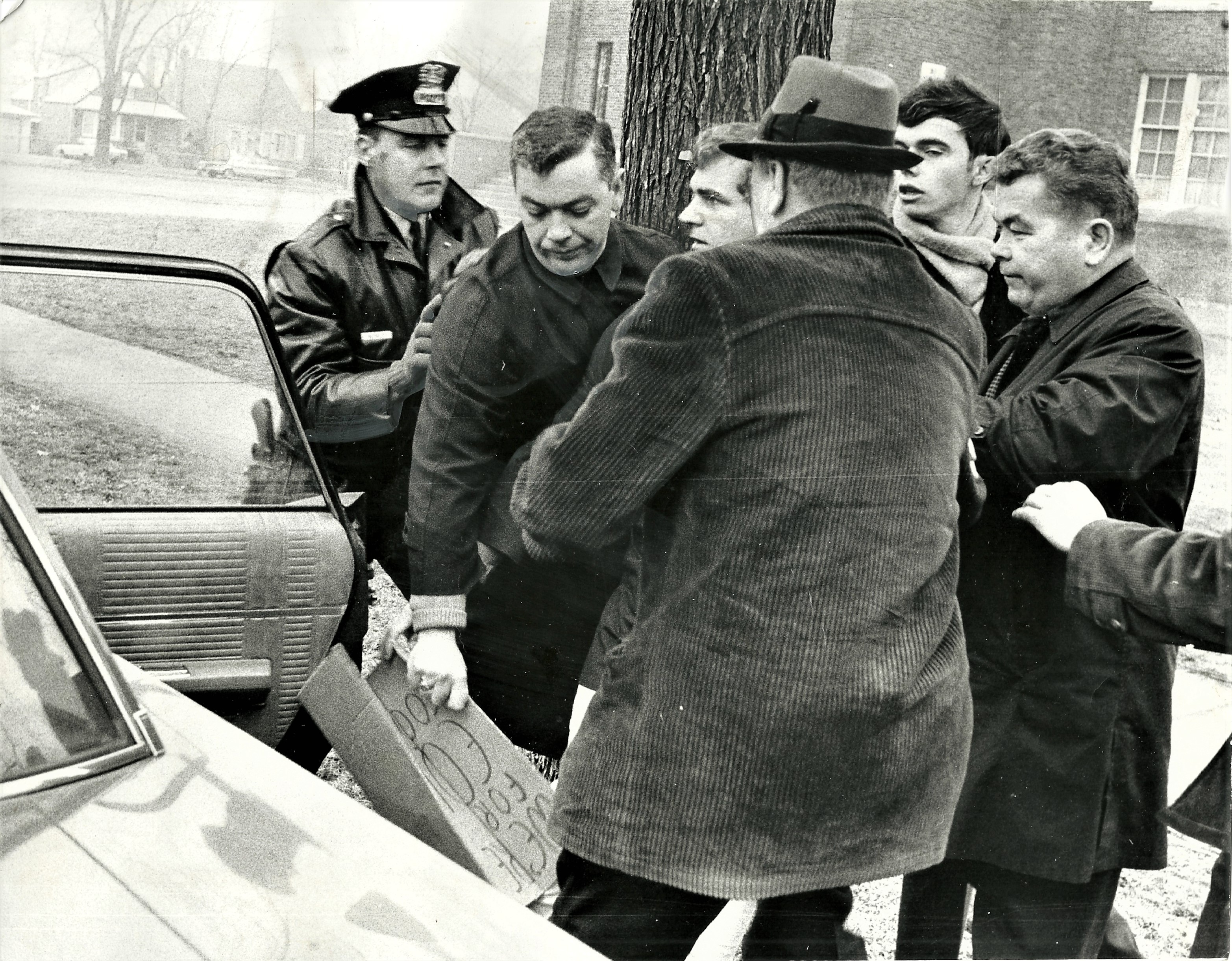
Will Leben (centre) and Terrence Burke (2nd from right) being strong-armed into unmarked police cars. –photo courtesy Duane Hall
Terrence Burke and Will Leben, counter-demonstrators who were attacked by the Mount Greenwood picketers, prevailed in legal fights that followed the incident.
Leben was slugged and the pair’s signs were destroyed by anti-integration demonstrators while police stood by, yet they were arrested and charged with disorderly conduct and resisting arrest. In December 1968, they were tried on those charges and found not guilty.
At the same time, their lawyers, provided by the American Civil Liberties Union (ACLU), filed suit in federal court asking for dismissal of charges against them, charging violation of a number of fundamental rights, and asked for $100,000 in damages for false arrest, false imprisonment, assault, and physical harm. In late 1970, the court entered a judgment of $5,000 against the Chicago police; earlier, in an out of court settlement, the two men charged in the attacks on Burke and Leben paid them a total of $1,400.
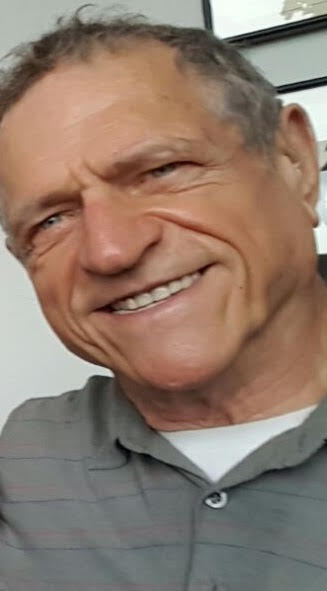
Will Leben today.
In interviews in 2016, Leben and Burke recalled their arrest as being more terrifying than the attack by the demonstrators. “It wasn’t so bad,” Leben, now professor of linguistics, emeritus, at Stanford University, said of the attack. “It’s just that by the point the police stepped in, it was not getting better. It was intensifying. We had a different reaction at the time, but if the police hadn’t broken it up, it would not have been good for us.
“The police never identified themselves as police, and they didn’t really speak to us. They just pushed us into unmarked cars.”
Burke, an emeritus professor of English at Cuyahoga Community College in Cleveland, said he experienced somewhat rougher treatment. He struggled with protesters trying to take his sign, “and then the next I knew was that I was grabbed by the throat and feet. I actually blacked out when they threw me into an unmarked police car before they took us to the Gresham police station.”
However, at the time, he didn’t know that he was in an unmarked police car, he added. He saw that Duane Hall, the Chicago Sun-Times photographer who documented the entire sequence of events, had come toward the car. “I was able to roll the window down, and I said, ‘Please tell me – are these policemen?’ because I really thought they might be neighbours who were going to take us to a garage and lynch us.”
It had been Burke’s idea to counter-demonstrate at Mount Greenwood. He was staying at his parents’ home in the neighbouring community of Beverly, still on Christmas break from the Cleveland college where he was an English professor. While in Chicago, he had use of his mother’s car during the day as long as he drove her to work at another Mount Greenwood-area school each morning. On the second day the black students were at the school, she asked him to drive past Mount Greenwood School on the way to her school, “and see what they’re doing to those poor kids,” he remembered her asking him.
“Nothing was happening as we drove by, but I went back and I saw these dozen little kids come in with their parents, running a gauntlet, while they were cussed. I don’t know if anybody spit on them, but it would have been terrifying.”
When he got back home, he tried to organize some Chicago friends to counter-demonstrate at the school. Leben was the only one who agreed.
The demonstrators were mostly women, so when Burke and Leben arrived at the school, they were greeted with shouts of, “Nice to see some men here!” and “Good for you, boys!”
“And then they actually read our signs and started to process it,” Burke said. “They decided to call us names – ‘pinko,’ ‘faggot.’ They started to try to grab the signs, and then that escalated. I never got struck, but Will did, and he also got kicked in the butt.”
Leben, who was a graduate student in linguistics at Northwestern University at the time, said the two hadn’t counted on being assaulted by the crowd, but they did expect their signs to be taken – so they brought extras.
“We were so naïve. I really think it was the first time we’d done anything like this. We said, ‘No doubt, people are going to try to rip our signs away so let’s make a few extras and put them in the trunk of the car.’ Neither of us expected to be physically attacked.” –Will Leben
“We were so naïve,” he said. “I really think it was the first time we’d done anything like this. We tried to figure out what was going to happen. We said, ‘No doubt, people are going to try to rip our signs away so let’s make a few extras and put them in the trunk of the car.’
“Neither of us expected to be physically attacked. That came as a surprise. But now, almost 50 years later, you look at the protesters at Trump rallies, and it’s the same stuff.”
One of their lawyers told a reporter when the suit against the Chicago Police Department was settled that neither Burke nor Leben “suffered permanent injury from their beatings.”
Far from “permanent injury,” Leben said he didn’t have so much as a bruise.
The only damage Burke feared was to his job. “That was my second year of teaching at Cuyahoga Community College,” he said. “I wasn’t sure at all that I wasn’t going to be fired as a result of this when they found out that I was about to go on trial.
“I was at that point, however, engaged to the very liberal dean’s secretary, so I felt emboldened to go into his office and tell him the whole story. He said, ‘You know, I’ve been an ACLU member for a lot of years. I’m with you. You don’t have anything to worry about.’ “
(Although he said nothing about it during the interview, Burke had been suffering from leukemia for more than a year, and died two months later, in June 2016.)
Mount Greenwood since 1968: Still the same
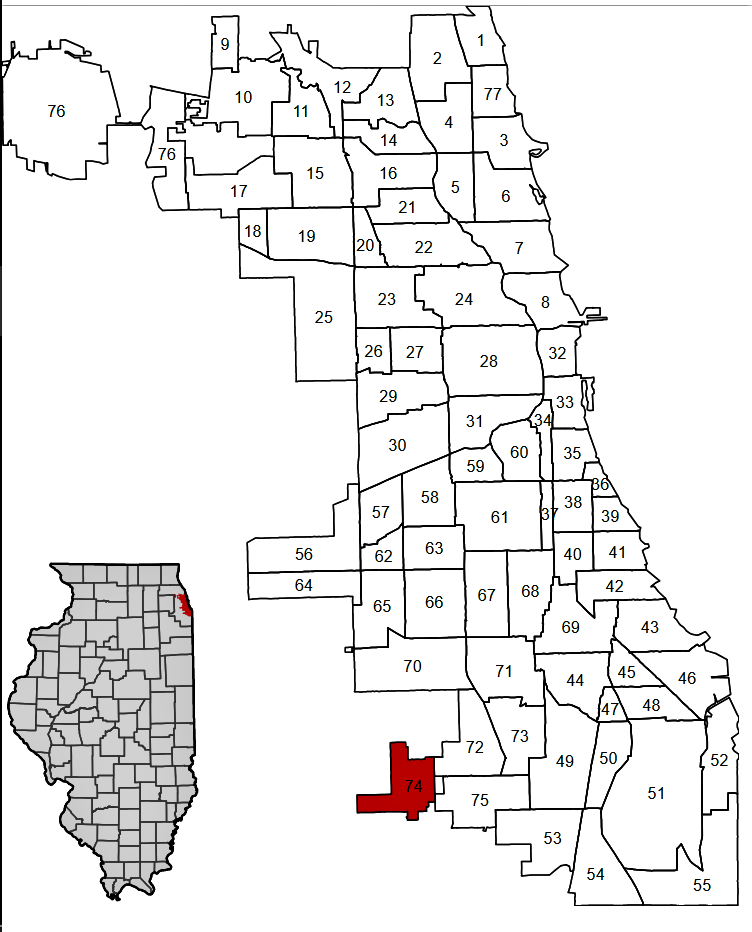
Mount Greenwood (in red) – the Far Southwest Side of Chicago. Credit: The Map Collection, University of Chicago Library, Christopher Siciliano, and Jeremy Atherton – Created by self (User:JeremyA) using an outline map from the Map Collection, University of Chicago Library and Christopher Siciliano – https://commons.wikimedia.org/w/index.php?curid=17638369
Nearly 25 years after the short-lived school desegregation, Mount Greenwood was little changed.
In 1992, when she was Chicago bureau chief for the New York Times, Isabel Wilkerson described the community as “an insular, ‘Leave It to Beaver’ world where white people can live out entire lives without ever getting to know a black person, where people rarely venture beyond understood borders.”
Fast-forward another quarter-century, to the present day, and the place is still the same. Racism persists in Mount Greenwood, and was on full display, a la 1968, in November 2016.
On the Saturday before the U.S. Presidential election, a white off-duty police officer shot and killed a 25-year-old black man who was driving through the neighbourhood after a family funeral. There are competing stories about exactly what happened: The police say the man, Joshua Beal, was stopped in traffic in front of a Chicago Fire Department station, blocking a fire lane. When an off-duty firefighter told him to move, Beal got out of his car and waved a gun. A police officer driving to work observed the confrontation, and stopped, drew his gun and demanded that Beal drop his weapon. Beal, who had a permit for the gun, didn’t drop it, was shot several times, and killed. Beal’s family, however, said the incident began when an off-duty police officer cut off members of the funeral procession in traffic.
The next day, about 20 Black Lives Matter protesters came to the site of the shooting, and were met by hundreds of white counter-demonstrators from the neighbourhood. In this confrontation and others over the following days, the local demonstrators shouted racial slurs, chanted “Blue Lives Matter” and “Trump, Trump, Trump,” and carried signs with slogans including, “You Are Animals #Go Home” and “You ruined your own communities, Don’t ruin ours.”
Adding to the tension was an exchange of racist texts by several white Catholic high school girls that was seen by an activist, who tweeted a screenshot of the messages: “I fucking hate niggers,” said one. Another responded, “Same.” Four girls were suspended and two others were expelled, prompting their parents to sue Marist High School for $1 million (U.S.). By January 2017, four of the girls had been readmitted to the school.
In the 2016 U.S. presidential election, Chicagoans voted overwhelmingly — more than 84% — for Hillary Clinton. Mount Greenwood stubbornly voted nearly 70% for Donald J. Trump, making it the most pro-Trump precinct in the city.
Unlike during the 1968 demonstrations at Mount Greenwood School, Chicago’s Catholic leader weighed in, and promptly. “Racism is a sin and has no place in the church, including the Archdiocese of Chicago,” Cardinal Blase J. Cupich commented about the Marist incident. “Our schools must be places where all are respected and the values of tolerance and peacemaking are taught and nurtured.”
In the 2016 U.S. presidential election, Chicagoans voted overwhelmingly — more than 84% — for Hillary Clinton. Mount Greenwood stubbornly voted nearly 70% for Donald J. Trump, making it the most pro-Trump precinct in the city.~TM
Copyright © Terry Murray 2018
[posted Saturday 6 October 2018]
Remembering Martin Luther King Jr.’s assassination 50 years later
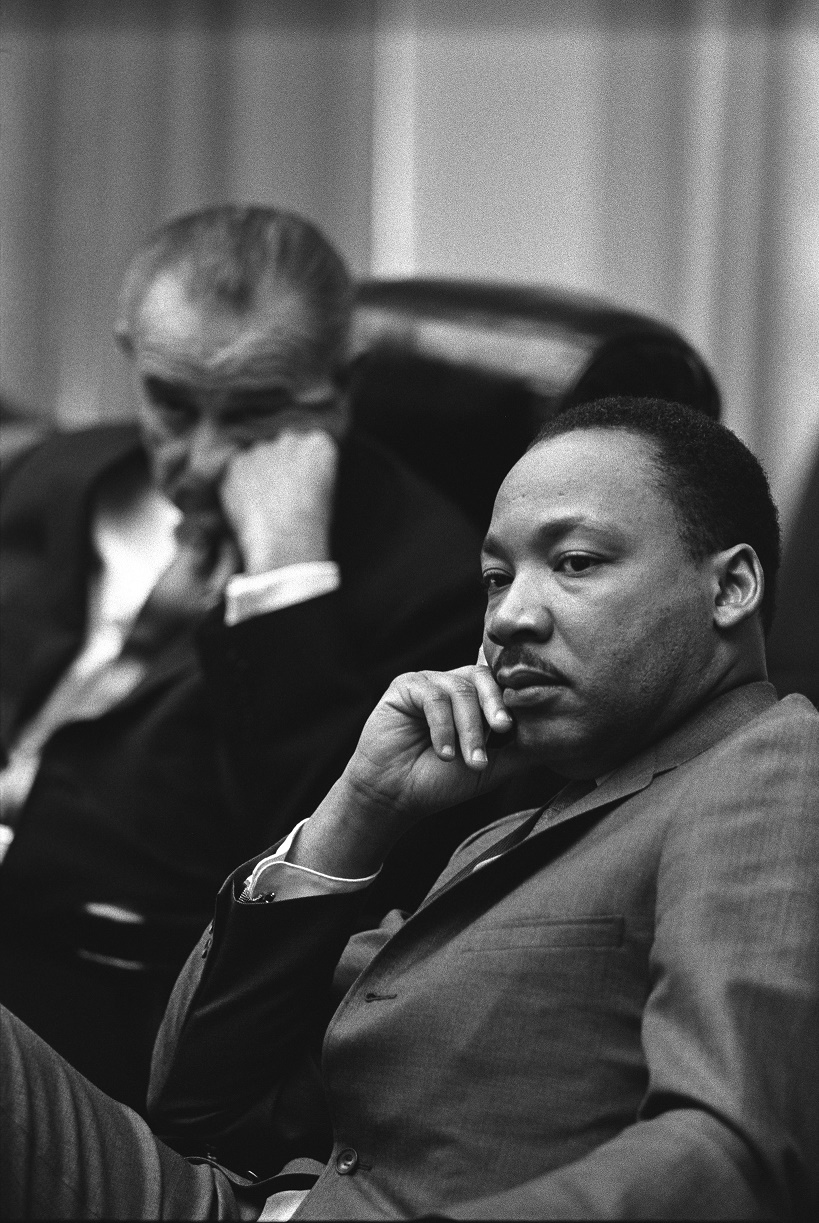
President Lyndon B. Johnson and Rev. Dr. Martin Luther King, Jr. in the Cabinet Room of the White House on 18 March 1966/LBJ Library photo by Yoichi Okamot
Fifty years ago this week, the Rev. Dr. Martin Luther King, Jr., was murdered. Anyone alive at the time, in North America at least, remembers where they were when they heard the news. Here’s my account, from my forthcoming memoir Red Squad.
King’s assassination came against the backdrop of ongoing unrest, including violent demonstrations, in Mount Greenwood, a white neighbourhood where I grew up on the Southwest Side of Chicago. The instigating event was the transfer of nine black students to the local public school in January 1968. The first full account of that event, a chapter in Red Squad, will appear in this summer’s issue of Taddle Creek magazine.
After dinner on Thursday 4 April, my mother, my younger sister Roxe and I went shopping. Easter was coming on the 14th, and we all needed new dresses. We went to Evergreen Plaza, the major shopping mall in our corner of the Southwest Side, and one that was integrated, drawing customers from surrounding white and black neighbourhoods.[i]
On our way to the girls’ clothing department of Carson Pirie Scott & Co., a major Chicago department store, we passed through the home entertainment section, where all the new TV sets were broadcasting the same image – President Lyndon B. Johnson.
“Why is LBJ on TV?” my mother asked, without stopping. It was just after 8pm and the store was open for only another hour. Mom wondered about the president being on TV in prime time because only five days earlier, on 31 March, he’d announced in a televised speech that he would not be seeking re-election: “I shall not seek, and I will not accept, the nomination of my party for another term as your President.”
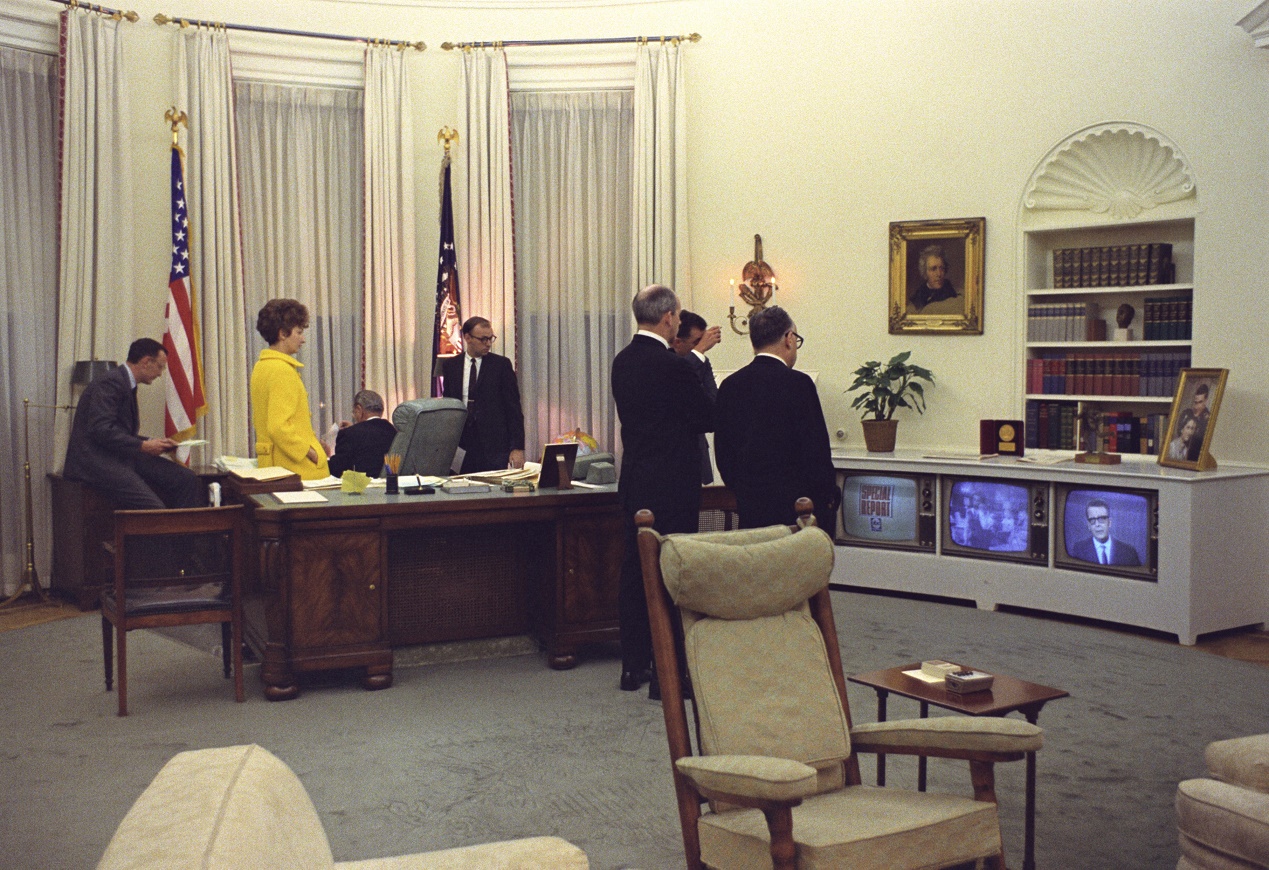
President Lyndon B. Johnson and members of his staff watch TV news reports about the assassination of Dr. Martin Luther King/LBJ Library photo by Mike Geissinger
When we returned home and as my mother parked the car, my father rushed outside, urging us, “Come inside! Come inside!”
“What’s the hurry?” we all asked.
“Martin Luther King has been killed and riots are breaking out,” Dad said.
In the days after King’s assassination, riots did indeed break out in 125 cities and towns across the U.S. Some began soon after news of the shooting – notably, in Washington, D.C. Rioting in Chicago began the next day.
LBJ’s TV appearance that night had been to announce King’s “brutal slaying” in Memphis, Tennessee. In his brief statement, broadcast on radio and TV, Johnson continued:
I ask every citizen to reject the blind violence that has struck Dr. King, who lived by nonviolence…. I have just conveyed the sympathy of Mrs. Johnson and myself to his widow, Mrs. King. I know that every American of good will joins me in mourning the death of this outstanding leader and in praying for peace and understanding throughout this land. We can achieve nothing by lawlessness and divisiveness among the American people. It is only by joining together and only by working together that we can continue to move toward equality and fulfillment for all of our people. I hope that all Americans tonight will search their hearts as they ponder this most tragic incident.
Perhaps the most moving, heartfelt eulogy of King was given that night by Senator Robert F. Kennedy, who was campaigning for the Democratic nomination in the U.S. presidential election to be held later that year. At a campaign stop in Indianapolis, Indiana, he broke the news of King’s murder to a largely black crowd and proceeded to memorialize the civil rights leader in extemporaneous remarks that are considered to be among the greatest American speeches of the 20th century.
Martin Luther King dedicated his life to love and to justice between fellow human beings. He died in the cause of that effort. In this difficult day, in this difficult time for the United States, it’s perhaps well to ask what kind of a nation we are and what direction we want to move in. For those of you who are black — considering the evidence evidently is that there were white people who were responsible — you can be filled with bitterness, and with hatred, and a desire for revenge.
We can move in that direction as a country, in greater polarization — black people amongst blacks, and white amongst whites, filled with hatred toward one another. Or we can make an effort, as Martin Luther King did, to understand, and to comprehend, and replace that violence, that stain of bloodshed that has spread across our land, with an effort to understand, compassion, and love.
Two months later, on 5 June, Kennedy himself was assassinated in Los Angeles, just after winning the Democratic primary in California.
[i] Evergreen Plaza opened in 1952, closed in 2013 and was demolished in 2015.
Red Squad: The introduction
The manuscript is finished, and out for consideration…
There is, one might say, a 50-year horizon for cultural memory, corresponding roughly to the life span of an adult. Once a period of history gets to be 50 years old, the sun of memory sets over that horizon and is replaced by the moonlight of myth. Moonlight is more romantic and produces shadows and glints that are invisible by day. But it is also not very good to see by; and myth never displays the past as accurately as history does, or tries to.
— Adam Kirsch[i]
While history happens at the level of great events, these micro-events get washed out. Yet, for the individuals, the latter are history: the past as looked at across a distance of 50, 60, 70 years. Who’s to say that their past, however individual and anecdotal, is any less history than the Big Story line we know in conventional narratives?
— Robert Darnton[ii]
*****
RED SQUAD
by Terry Murray
Chapter 1: Introduction
Before the National Security Agency in the U.S. and the Communications Security Establishment in Canada, there was the Red Squad in Chicago. From the 1880s through the 1970s, this arm of the Chicago Police Department (CPD) kept tabs on anarchists, labour activists, Communists and people thought to be Communist, civil rights groups and people who opposed the Vietnam War — political dissenters militant or mild. The Red Squad’s techniques of overt and covert surveillance and infiltration were cruder than those used in the digital age — even ham-handed — but they were no less effective.
Even before the Red Squad was shut down after 11 years of litigation by a 1985 court decision and its files released to a Chicago archive, my parents knew, from comments made by employers and by the squad’s less than subtle techniques, that they were in its records. What earned them that distinction? In the late 1960s, they had worked to support the desegregation of the public school in our conservative, white South Side neighbourhood, and independently produced an innovative programme for preparing underemployed young black adults for lucrative jobs in the nascent computer industry.
All of us – my parents, my sisters and I – also opposed the Vietnam War, although it was principally I who demonstrated, organized study sessions and arranged speaking engagements for more radical activists.
Although entirely lawful, all those activities had negative repercussions: We were ostracized by our neighbours, our house was bombed and my father was forced out of his job with IBM.
Our Red Squad files (I later learned that I had a file too, although I was only 16 at the time), don’t contain documentation of all of those activities. But the threat of surveillance, not to mention the actual reports sent to my father’s employer, made the Red Squad emblematic of those years and coloured the rest of our lives. The events of that time led to the dissolution of my parents’ marriage and to one of my sisters and me leaving the U.S. for Canada, where we continue to live. My other sister, quite young (aged eight to 10 years old) at the time, remained in the U.S. but of course was also affected by the aftermath of those days.
Perhaps the most unexpected outcome of all was that my once-progressive father turned his back on his pioneering efforts and the principles he had espoused, and became increasingly racist and politically and socially conservative. My mother clung to her beliefs, and the resulting rift between my parents was a major contributor to their divorce nearly 10 years later.
After I decided to write my family’s story, Go Set a Watchman, Harper Lee’s prequel/sequel to To Kill a Mockingbird, was published. The publication was met with widespread outrage that Atticus Finch, the near-saintly paragon of racial justice of Mockingbird, was revealed to be a racist in Watchman. It didn’t seem impossible to me, given my father’s about-face, which mystified me for many years, until I began to examine his life more closely in reviewing the events of the late 1960s.
This book, however, is not an exercise in therapy, to try to come to terms with his puzzling behaviour. Instead, I want to pay tribute to my parents’ courage and forward thinking, my father’s reversal notwithstanding, which shaped my sisters and me.
My family’s story also illuminates an under-reported event from that time: the desegregation, in early 1968, of Mount Greenwood Elementary School, that South Side Chicago public school, which produced neighbourhood protests reminiscent of those accompanying the integration of Central High School in Little Rock, Arkansas, 10 years earlier. That may be an overstatement of the incident’s significance, but several chroniclers of that tumultuous decade agree that it was an important and overlooked chapter in Chicago’s civil rights history, and one that continues to reverberate.
Chicago itself was important because it was the first Northern city chosen by Martin Luther King, Jr., as a testing ground for his non-violent civil rights efforts that had been successful in the South. His focus shifted from voting and other Constitutionally-guaranteed rights that had largely been secured, at least in legislation, in 1964 and 1965, and he changed the priority of the Chicago movement from schools to housing. The transplantation of those efforts in the North has been judged as largely unsuccessful, and Chicago remains one of the most segregated cities in the U.S.
The major events in my family’s story occurred between 1967 and 1970, a period during which the civil rights movement is often said to have ended, even before King’s assassination in 1968. If that was the case, no one told the people of Chicago, or my neighbours, and recent events – racially-motivated killings and the rise of Donald Trump as a political force in the U.S. – show the need for it is far from over.
And, as the revelations by Edward Snowden and others have shown, the age of government surveillance in the U.S., Canada and elsewhere isn’t over either, and may have simply taken a new form.
[i] “My Jewish Mother Was a Communist, and Other Tales of Lost Leftists,” by Adam Kirsch, Tablet magazine, 3 September 2013 – review of Dissident Gardens by Jonathan Lethem; http://tabletmag.com/jewish-arts-and-culture/books/142934/kirsch-lethem-dissident-gardens (accessed 30 May 2015)
[ii] Robert Darnton, quoted in Almost a Family, by John Darnton; Anchor, 2012, p. 235.
Copyright © Terry Murray 2016
All material copyright © Terry Murray 2014-2022 unless indicated otherwise

